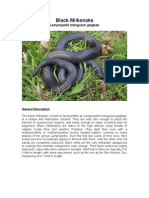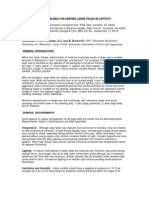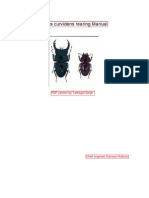Green Tree Python2
Green Tree Python2
Uploaded by
Fajar Andrianto FurqonCopyright:
Available Formats
Green Tree Python2
Green Tree Python2
Uploaded by
Fajar Andrianto FurqonCopyright
Available Formats
Share this document
Did you find this document useful?
Is this content inappropriate?
Copyright:
Available Formats
Green Tree Python2
Green Tree Python2
Uploaded by
Fajar Andrianto FurqonCopyright:
Available Formats
Green Tree Python
Morelia viridis
The Green Tree Python is one of the most beautiful pythons and despite its name can be found in other colors including yellow and blue. It is a true arboreal snake where almost all of its activities will take place off the ground. Wild caught specimens tend to be aggressive but captive bred specimens can be quite docile unless provoked. These pythons are not recommended for beginner keepers.
Average Size 5 - 7 ft in length Life Span 20 + years with proper care.
Diet Feeding
Thawed, appropriate sized frozen rodents, warmed to room temperature. Feed most adult snakes every two weeks, or as needed; juveniles once or twice a week. Feed in a separate tanks so that your snake does not associate your hand or the habitat being opened with feeding. Use caution while feeding Green Tree Pythons as they have an incredible striking distance. If feeding your snake live rodents, do not leave them unattended. Live rodents can injure the snake, sometimes fatally.
Housing
Size Appropriate size and shape habitat to accommodate normal behaviors and exercise. Substrate Aspen shavings, mulch-type commercial material; unbleached paper towels, soil, dampened sphagnum moss, and bark. Habitat Enclosure should be fitted with branches, a water bowl, some fake plants (like Ivy for a bit of privacy) and a couple of hides. Temperature Temperature should be maintained at 85 F during the day and 75 F at night; recommend radiant heat; use an incandescent light or ceramic heat emitter as primary heat source; high humidity is required, monitor the animal for humidity related health issues. Lighting Snakes need a photo period light cycle; provide 8-12 hours of light daily; do not leave white light on at all times; to view snakes at night, use a black or infrared light. Water Provide a water bowl of chlorine-free water large enough for the snake to soak in. DO NOT house different species of reptiles together.
Recommended Supplies
Habitat with secure lid or door. Appropriate substrate. Water dish. Sturdy branch or shelf for climbing. Hiding or retreat area.
Hiding or retreat area. Incandescent bulb or ceramic heat emitter. Thermometer and humidity gauge. Infrared or black light. Lighting timer.
Habitat Maintenance
Clean out water dish and replace water dish daily; remove any feces daily, or food if not eaten. Thoroughly clean the tank at least once a week: set snake aside in a secure habitat; scrub the tank and furnishings with a reptile habitat cleaner or 3% bleach solution; rinse thoroughly with water, removing all smell if bleach if used; dry the tank and furnishings; add clean substrate.
Green Tree Python
Morelia viridis
Normal Behavior & Interaction As snake gets ready to shed, eyes will turn milky blue over the course of a few days and body color will start to dull and develop a whitish sheen. Will coil around branches most of time; should display an alert demeanor when disturbed. Will search habitat when hungry. Use caution with Green Tree Pythons as they have an incredible strike distance.
Grooming & Hygiene
Snakes will regularly shed their skin; if old pieces of skin remain after shedding, mist the snake and gently rub off the old skin. This may be difficult with Green Tree Pythons as they are extremely difficult to remove from their branch and may bite. Ensure humidity is correct and mist often to decrease chances of an irregular shed. Always wash your hands before and after handling your snake or habitat contents to help prevent Salmonella and other diseases.
Signs of a Healthy Animal
Active & alert. Clear eyes. Healthy skin.
Symptoms or Causes
Eats regularly. Regularly shedding of skin. Shed skin in one complete piece.
Common Health Issues
Health Issue Dermatitis
Suggested Action Clean the habitat and lower humidity. Consult your exotic animal veterinarian.
Blisters; rapid shedding cause by an unclean habitat or one that is too cold or damp.
Respiratory Disease, such as colds
Labored breathing. Mucus in mouth or nostrils. Can be caused by a habitat that is too cold or damp.
Keep snake warm and dry. Consult your exotic animal veterinarian.
Stomatitis
White, cheesy substance in the mouth; loss of teeth and appetite.
If left untreated, can be fatal. Consult your exotic animal veterinarian. Consult your exotic animal veterinarian.
Ticks & Mites
Parasites on skin, can transmit diseases.
Red Flags
Unusually frequent or infrequent shedding. Lethargic or reluctant to eat; weight loss. Abnormal feces. Difficulty shedding
Vomiting. Bumps or spots on skin. Labored breathing White, cheesy substance in mouth.
If you notice any of these signs, please contact your exotic animal veterinarian. Note: The information on our care sheets was collected from various sources as well as our own experiences. These care sheets are a guideline only, not a substitute for veterinary care and should not be used as such. If you need additional information, we highly recommend doing your own research. There are also multiple reptile forums online. For any potential health issues, please contact your exotic animal veterinarian.
You might also like
- 2004-2015 Toyota Hilux Fuse Box Diagram Fuse DiagramDocument12 pages2004-2015 Toyota Hilux Fuse Box Diagram Fuse DiagramJunior Salazar100% (4)
- U170 Yr7 ES Leaflet PDFDocument36 pagesU170 Yr7 ES Leaflet PDFAFuentesCaballero60% (5)
- MATLAB - Rudra PratapDocument252 pagesMATLAB - Rudra PratapAnirban Chakraborty89% (18)
- Care Sheet - Egyptian Sand GeckoDocument2 pagesCare Sheet - Egyptian Sand GeckoJohn GamesbyNo ratings yet
- The Herpetoculture of Leopard Geckos Twenty Seven Generations of Living ArtDocument22 pagesThe Herpetoculture of Leopard Geckos Twenty Seven Generations of Living ArtVlad UrtaNo ratings yet
- Care Sheet - Fat Tailed GeckoDocument2 pagesCare Sheet - Fat Tailed GeckoJohn GamesbyNo ratings yet
- Care Sheet - Diones Rat SnakeDocument2 pagesCare Sheet - Diones Rat SnakeJohn GamesbyNo ratings yet
- Care Sheet - Green Bush Rat SnakeDocument2 pagesCare Sheet - Green Bush Rat SnakeJohn GamesbyNo ratings yet
- Husbandry AmphibianDocument49 pagesHusbandry AmphibianLuiz Mello Lula100% (1)
- Ellieovalle ScienceresearchpaperDocument4 pagesEllieovalle Scienceresearchpaperapi-252167632No ratings yet
- How To Anaesthetize A GiraffeDocument4 pagesHow To Anaesthetize A Giraffeltrathie3087100% (2)
- Care Sheet - Childrens PythonDocument2 pagesCare Sheet - Childrens PythonJohn Gamesby100% (1)
- Care Sheet - African House Snake (Lamprophis)Document2 pagesCare Sheet - African House Snake (Lamprophis)John GamesbyNo ratings yet
- Feeding and Nutrition of AnteatersDocument6 pagesFeeding and Nutrition of AnteatersDidaNo ratings yet
- Bird VisionDocument13 pagesBird VisionХристинаГулеваNo ratings yet
- AWS C5.2-01 Plasma Arc CuttingDocument53 pagesAWS C5.2-01 Plasma Arc CuttingvenkateshNo ratings yet
- AlliterationDocument4 pagesAlliterationapi-284232017No ratings yet
- Linear Algebra Cheat SheetDocument2 pagesLinear Algebra Cheat SheetNooraniManshadNo ratings yet
- Russian Tortoise: Care SheetDocument2 pagesRussian Tortoise: Care Sheetg808853No ratings yet
- Bearded DragonDocument2 pagesBearded Dragonapi-202831082No ratings yet
- Blue and Gold Macaw: Ara AraraunaDocument2 pagesBlue and Gold Macaw: Ara AraraunaNikic NikoNo ratings yet
- All Abuot Finch PDFDocument2 pagesAll Abuot Finch PDFblackvenumNo ratings yet
- Ball PythonDocument1 pageBall PythonEric RoscoeNo ratings yet
- Care Sheet - Carpet PythonDocument2 pagesCare Sheet - Carpet PythonJohn GamesbyNo ratings yet
- Manatee: Manatees (Family Trichechidae, Genus Trichechus) Are Large, Fully AquaticDocument12 pagesManatee: Manatees (Family Trichechidae, Genus Trichechus) Are Large, Fully AquaticalexcusNo ratings yet
- Care Sheet - Common BoaDocument2 pagesCare Sheet - Common BoaJohn GamesbyNo ratings yet
- Anatomy and Disorders Oral of Reptiles PDFDocument18 pagesAnatomy and Disorders Oral of Reptiles PDFGeovanni LunaNo ratings yet
- Corn Snake Care SheetDocument14 pagesCorn Snake Care SheetlulavcNo ratings yet
- ReptilesDocument34 pagesReptilesZevannayasmineNo ratings yet
- Pain and Its Control in R 2018 Veterinary Clinics of North America Exotic ADocument16 pagesPain and Its Control in R 2018 Veterinary Clinics of North America Exotic AYaiza Garcia CasadoNo ratings yet
- Care Sheet - Amazon Tree Boa (Corallus Hortulanus)Document3 pagesCare Sheet - Amazon Tree Boa (Corallus Hortulanus)John GamesbyNo ratings yet
- Black Milksnake CaresheetDocument3 pagesBlack Milksnake CaresheetNathaniel GodinNo ratings yet
- Arthropods: Camilo B. Santos M.D Department of Microbiology & Parasitology Emilio Aguinaldo College of MedicineDocument61 pagesArthropods: Camilo B. Santos M.D Department of Microbiology & Parasitology Emilio Aguinaldo College of MedicineBea SamonteNo ratings yet
- Crested Geckos: A Beginner's Guide to Happy and Healthy GeckosFrom EverandCrested Geckos: A Beginner's Guide to Happy and Healthy GeckosNo ratings yet
- Centipede and Millipede CareDocument5 pagesCentipede and Millipede CareTurel626No ratings yet
- Care Sheet - Great Plains Rat SnakeDocument2 pagesCare Sheet - Great Plains Rat SnakeJohn GamesbyNo ratings yet
- Adaptation and Evolution AxolotlDocument25 pagesAdaptation and Evolution Axolotlapi-32054921267% (3)
- Care Sheet - Green IguanaDocument6 pagesCare Sheet - Green IguanaJohn GamesbyNo ratings yet
- Chapter 2 Snakes of Papua New GuineaDocument23 pagesChapter 2 Snakes of Papua New GuineaIrfan Haidar BasyirNo ratings yet
- Metabolic Diseases in Zoo and Wild AnimalsDocument40 pagesMetabolic Diseases in Zoo and Wild AnimalsAbhishek MandaranaNo ratings yet
- Care Sheet - Bull SnakeDocument3 pagesCare Sheet - Bull SnakeJohn GamesbyNo ratings yet
- Animal TrainingDocument44 pagesAnimal TrainingMunir Yusufzai100% (1)
- Osmoregulation in Marine MammalsDocument14 pagesOsmoregulation in Marine MammalsTapan Kumar PalNo ratings yet
- Birds and Exotics - MCannon PDFDocument42 pagesBirds and Exotics - MCannon PDFAl OyNo ratings yet
- Arcadia Reptile 2018Document32 pagesArcadia Reptile 2018marianpcbNo ratings yet
- Reptiles - Snakes - Python Fact SheetDocument2 pagesReptiles - Snakes - Python Fact SheetUwaisNo ratings yet
- Kingdom Animalia: Lita Puspa Dewi 1162060061Document11 pagesKingdom Animalia: Lita Puspa Dewi 1162060061Lita Puspa DewiNo ratings yet
- Avian Renal System Clinical ImplicationsDocument19 pagesAvian Renal System Clinical ImplicationsAnais FaveroNo ratings yet
- Lecture 11. Avian Nervous SystemDocument6 pagesLecture 11. Avian Nervous SystemCube MaximNo ratings yet
- Avian Anatomy and Physiology: Christine Fiorello, DVM, PHD, Dipl. AczmDocument49 pagesAvian Anatomy and Physiology: Christine Fiorello, DVM, PHD, Dipl. AczmARKADENo ratings yet
- Characteristics of ReptilesDocument2 pagesCharacteristics of ReptilesPatricia HariramaniNo ratings yet
- Taurine and Zoo Felids Considerations of Dietary and Biological Tissue Concentrations 2007 Zoo BiologyDocument15 pagesTaurine and Zoo Felids Considerations of Dietary and Biological Tissue Concentrations 2007 Zoo BiologygabrielwerneckNo ratings yet
- Sugar Glider BISDocument4 pagesSugar Glider BISFadly BoizNo ratings yet
- Zoo Guidelines For Keeping Large Felids in CaptivityDocument5 pagesZoo Guidelines For Keeping Large Felids in CaptivitySadaqat AliNo ratings yet
- HedgehogDocument9 pagesHedgehogRalph Laurence GulfoNo ratings yet
- UltrasonographyDocument21 pagesUltrasonographyChecko LatteNo ratings yet
- Wild DogsDocument198 pagesWild DogsLauraNo ratings yet
- Dwarf Boas of The Caribbean PDFDocument5 pagesDwarf Boas of The Caribbean PDFJohn GamesbyNo ratings yet
- Jawless, Bony, and Cartilaginous Fishes: Reported By: Bagundol, Jamie Gellamucho Bsed-Biology IiiDocument30 pagesJawless, Bony, and Cartilaginous Fishes: Reported By: Bagundol, Jamie Gellamucho Bsed-Biology IiiJamie BagundolNo ratings yet
- Gnathiferans and Smaller LophotrochozoansDocument36 pagesGnathiferans and Smaller LophotrochozoansLiz Hackett100% (1)
- Ookuwagata Rearing Manual (Stag Beetles Rearing Manual)Document25 pagesOokuwagata Rearing Manual (Stag Beetles Rearing Manual)Tathagat_No ratings yet
- A Guide To Zooplankton Of: The NortheasternDocument38 pagesA Guide To Zooplankton Of: The NortheasternRaquel SilvaNo ratings yet
- Final Exam GradesDocument4 pagesFinal Exam GradesHANI SbinatiNo ratings yet
- Case 2Document3 pagesCase 2gudetaNo ratings yet
- Revision Worksheet - Obsessive-Compulsive Disorder (OCD)Document2 pagesRevision Worksheet - Obsessive-Compulsive Disorder (OCD)thamhuong1111No ratings yet
- Desa Laguna Brochure 2023 v2-5Document40 pagesDesa Laguna Brochure 2023 v2-5freddysh4330No ratings yet
- Paper Sharad MishraDocument12 pagesPaper Sharad Mishramishrasarad75No ratings yet
- Presentation - AES Standard For Audio Application of Networks High-Performances Streaming Audio-over-IP InteroperabilityDocument24 pagesPresentation - AES Standard For Audio Application of Networks High-Performances Streaming Audio-over-IP Interoperabilityscrt5No ratings yet
- Subcontracting in Textile and Clothing Sector in BangladeshDocument5 pagesSubcontracting in Textile and Clothing Sector in BangladeshAbrar Ahmed ApuNo ratings yet
- Management Controls and Strategic Performance Measurement STRATEGIC Invesment Units and Transfer PricingDocument97 pagesManagement Controls and Strategic Performance Measurement STRATEGIC Invesment Units and Transfer Pricingspongebob SquarepantsNo ratings yet
- Activity GlobalizationDocument5 pagesActivity GlobalizationVince BulayogNo ratings yet
- Task Force StructureDocument14 pagesTask Force StructureAlex B. MolinaNo ratings yet
- BlackbirdDocument4 pagesBlackbirdorigamibooksNo ratings yet
- E3 Grammar Reference and Glossary With Intro in EnglishDocument18 pagesE3 Grammar Reference and Glossary With Intro in EnglishFabio Molinaris100% (1)
- Solving Problems (Lecture 23B)Document6 pagesSolving Problems (Lecture 23B)Suraj sssNo ratings yet
- Topic 1 - Defining Leader & LeadershipDocument39 pagesTopic 1 - Defining Leader & LeadershipMuntasir AhmmedNo ratings yet
- E6010 - 16020415Document4 pagesE6010 - 16020415Arvind SahaniNo ratings yet
- Divisions of Art StudyDocument21 pagesDivisions of Art StudyJewel SkyNo ratings yet
- Case Study - Platinum - Hyundai Accent 2016 1.6L V1Document2 pagesCase Study - Platinum - Hyundai Accent 2016 1.6L V1quỳnh trầnNo ratings yet
- Associated Injuries in Patients With Maxillofacial FracturesDocument5 pagesAssociated Injuries in Patients With Maxillofacial FracturesFriska GriffinNo ratings yet
- Step and Touch Voltage Update For 2004 090804Document23 pagesStep and Touch Voltage Update For 2004 090804Tamador HammashNo ratings yet
- Google HCIA TranslationDocument45 pagesGoogle HCIA Translationolapade paulNo ratings yet
- Ni 442 17Document3 pagesNi 442 17Mohamad AlwanNo ratings yet
- Module 10Document6 pagesModule 10Hazel PotterNo ratings yet
- Hindi Teaching Incentive Scheme: 1.0 TitleDocument6 pagesHindi Teaching Incentive Scheme: 1.0 TitleAshwini SreedharNo ratings yet
- Moisture Tolerant Protective Barrier Coating: Belzona® 5831Document2 pagesMoisture Tolerant Protective Barrier Coating: Belzona® 5831Wong Chung MengNo ratings yet

























































































